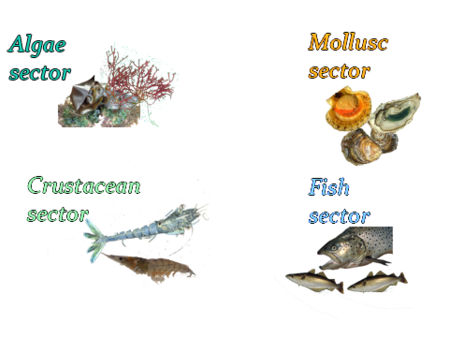Introduction
Presentation
Fish farming = Aquaculture of Fish
Fish farming is mainly done in fresh water (87 %), and is above all a type of subsistence aquaculture, providing animal protein for local populations. Asian carp are the most important species by far (common carp, grass carp, silver carp, bighead carp etc.), representing 19.5 million tonnes. Salmonid production is close to 2.0 million tonnes, with two large producers : Norway followed by Chile. Then come the tilapias, milkfish, catfish and eels. Yields vary from 100 kg per hectare (extensive) to 100 kg per m3 (intensive).
Marine fish farming represents 9% of world fish production. Amberjack (reared in Japan) have been produced at a stable level (about 150 000 tonnes) since 1980, while other species have seen their totals rise by a factor of 47 during the same period. In 1980, 17 different species were reared. In 2005 this had grown to more than 70.
History
by Yves Harache and Jean Louis Gaignon
Fish farming is an ancient activity. Pond growing of carp in China and tilapia in Egypt (see Photo 1), was being done in 2000 BC. The Romans grew fish in “viviers” (Photo 2).
In Europe, fish farming in ponds developed in the middle ages with the spread of the monasteries. In the 15th century, fish were captured as they swam up into brackish waters and were maintained in pools (see photo below).
The first fish farming trials are however credited to Jacobi, who performed the first successful artificial fertilisations of salmonids in 1763. It then wasn’t until the time of “aquimania fever”, extolling “shores everywhere converted into aquatic farms”, that the first “marine fish factories” were created (in 1878 in the United States and 1883 in Norway). Work was done on all species. For example, artificial reproduction and fertilisation of turbot were done as early as 1894 in England. Work done at St Vaast la Hougue in 1898 led Malard to write the following year: “Turbot farming will be possible and relatively easy”. It was also at the end of the 19th and beginning of the 20th century that great efforts were made in transferring salmon populations between regions throughout the world (1875 : California to New Zealand).At the same time, in the 1890s, trout farming started in Denmark. It grew considerably at the end of the 1960s as the fishes’ diet, hitherto based on fresh fish scraps from canneries etc. (which explains why such fish farms developed in Brittany, France, alongside the fisheries and canneries), was replaced by pelleted food. “New aquaculture”, which refers to sea aquaculture, started in Japan at the end of the 1970s with the on-growing of Amberjack (Seriola), in Norway with the first trout cage trials, and at research institutes in England, France and elsewhere with studies on the control of reproductive cycles. The first turbot larva was thus produced in 1972 at the CNEXO (which has since become IFREMER).
Photos: Yves Harache
Production methods
Fish farming, as its history suggests, is a highly diversified activity, varying according to the environment, objectives and methods used.
Rearing may cover all, or just some, of the biological cycle. In certain cases, only juveniles are produced, as is the case when young salmon produced in aquaculture are released for restocking or sea ranching. The opposite case is when controlled reproduction is not possible but it is possible to on-grow or fatten young wild fish. This is has been the case with the Amberjack in Japan for the last 30 years, and has also been used for bluefin tuna over the last few years. However, this means of production cannot easily develop further or become permanent without development towards complete control over the biological cycle.
Aquaculture in the strict sense refers to an activity based on the complete controlled production cycle of a fish species: from eggs to breeders. In cases like this the production methods are very varied : from rearing in ponds with no added food to fully controlled systems including water treatment and recycling. In practice, extensive aquacultural production is generally subsistence aquaculture or even, as in France, a form of land management for leisure activities (recreational fishing). More intensive production can only be envisaged for high value products. This is the case for juveniles (hatchery production) or when there are specific existing markets for consumption.

